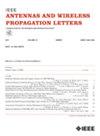Si-Cylinder Arrays on InAs for Electromagnetic Nonreciprocal Radiation With 0.5 T Magnetic Field and 3° Angle
IF 4.8
2区 计算机科学
Q2 ENGINEERING, ELECTRICAL & ELECTRONIC
引用次数: 0
Abstract
In recent years, nonreciprocity of nonequilibrium radiation has demonstrated significant possibility for practical value, where the nonreciprocal radiation has successfully mitigated the limitations imposed by Kirchhoff’s law. In this study, we investigate the pronounced nonreciprocal radiation characteristics of a dual-polarized silicon cylindrical array under low magnetic field and small angle. The array structure consists of multiple layers: a silicon cylindrical layer, a silicon rectangular layer, an InAs layer, and an Ag rectangular layer. This unique configuration enables the exploration of novel radiation phenomena in the weak external magnetic field and less angle. By investigating the physical mechanisms governing electromagnetic field energy distribution, we have achieved a nonreciprocity exceeding 90% between TE polarization and TM polarization in radiation. This remarkable result is obtained at low magnetic fields, specifically at an intensity of 0.5 T and an angle of 3°. In contrast to conventional nonreciprocal radiation structures, this study significantly diminishes reliance on external magnetic fields and incidence angles. It is anticipated that it will offer fresh perspectives and innovative approaches in the field of nonreciprocal radiation and energy transfer research.磁场为0.5 T、角度为3°的电磁非互反辐射中硅柱阵列在InAs上的应用
近年来,非平衡态辐射的非互易性已经显示出了重要的实用价值,其中非互易辐射已经成功地减轻了基尔霍夫定律所施加的限制。在本研究中,我们研究了双极化硅圆柱阵列在低磁场和小角度下明显的非互反辐射特性。该阵列结构由多层组成:硅柱层、硅矩形层、InAs层和银矩形层。这种独特的结构使得在弱外磁场和小角度下探索新的辐射现象成为可能。通过研究控制电磁场能量分布的物理机制,我们实现了辐射中TE极化和TM极化之间超过90%的非互易性。这一显著的结果是在低磁场下获得的,特别是在强度为0.5 T和角度为3°的情况下。与传统的非互反辐射结构相比,本研究显著减少了对外部磁场和入射角的依赖。预计它将为非互反辐射和能量传递研究领域提供新的视角和创新的方法。
本文章由计算机程序翻译,如有差异,请以英文原文为准。
求助全文
约1分钟内获得全文
求助全文
来源期刊
CiteScore
8.00
自引率
9.50%
发文量
529
审稿时长
1.0 months
期刊介绍:
IEEE Antennas and Wireless Propagation Letters (AWP Letters) is devoted to the rapid electronic publication of short manuscripts in the technical areas of Antennas and Wireless Propagation. These are areas of competence for the IEEE Antennas and Propagation Society (AP-S). AWPL aims to be one of the "fastest" journals among IEEE publications. This means that for papers that are eventually accepted, it is intended that an author may expect his or her paper to appear in IEEE Xplore, on average, around two months after submission.

 求助内容:
求助内容: 应助结果提醒方式:
应助结果提醒方式:


